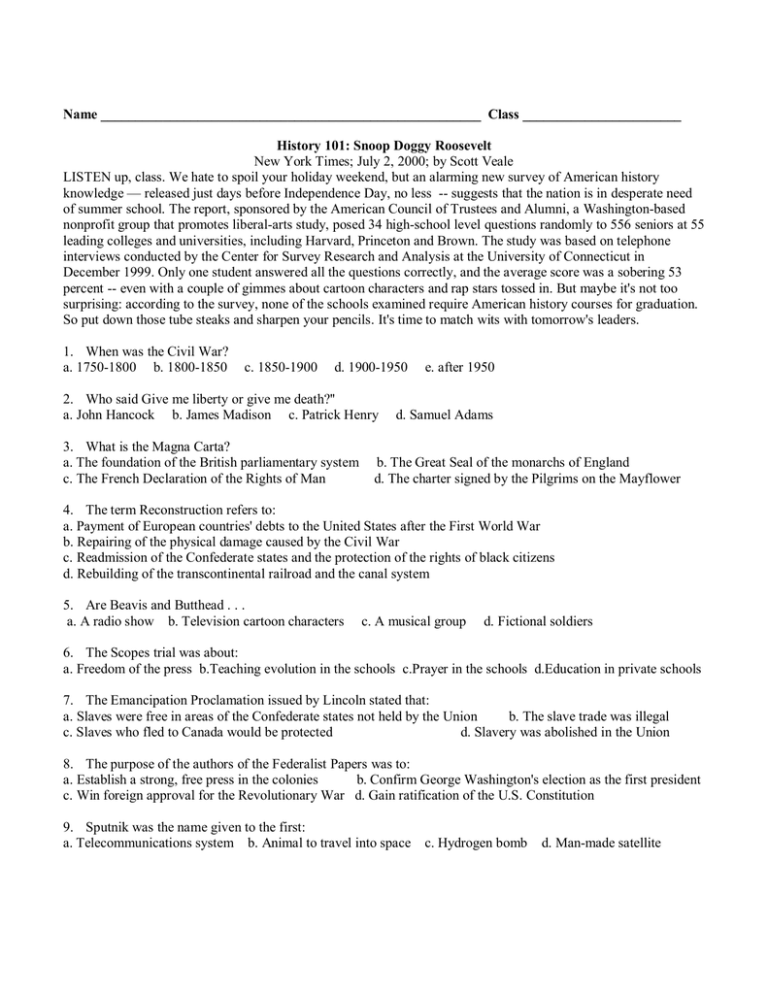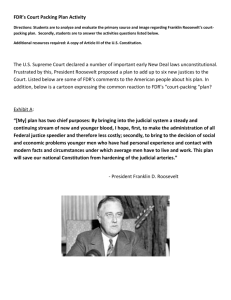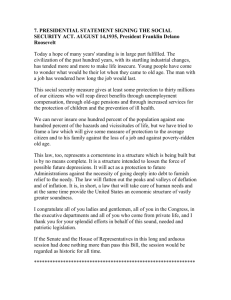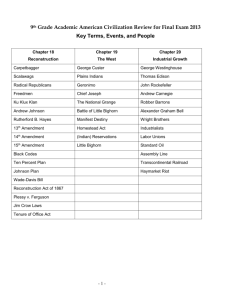Name _______________________________________________________ Class _______________________ History 101: Snoop Doggy Roosevelt
advertisement

Name _______________________________________________________ Class _______________________ History 101: Snoop Doggy Roosevelt New York Times; July 2, 2000; by Scott Veale LISTEN up, class. We hate to spoil your holiday weekend, but an alarming new survey of American history knowledge — released just days before Independence Day, no less -- suggests that the nation is in desperate need of summer school. The report, sponsored by the American Council of Trustees and Alumni, a Washington-based nonprofit group that promotes liberal-arts study, posed 34 high-school level questions randomly to 556 seniors at 55 leading colleges and universities, including Harvard, Princeton and Brown. The study was based on telephone interviews conducted by the Center for Survey Research and Analysis at the University of Connecticut in December 1999. Only one student answered all the questions correctly, and the average score was a sobering 53 percent -- even with a couple of gimmes about cartoon characters and rap stars tossed in. But maybe it's not too surprising: according to the survey, none of the schools examined require American history courses for graduation. So put down those tube steaks and sharpen your pencils. It's time to match wits with tomorrow's leaders. 1. When was the Civil War? a. 1750-1800 b. 1800-1850 c. 1850-1900 d. 1900-1950 2. Who said Give me liberty or give me death?'' a. John Hancock b. James Madison c. Patrick Henry 3. What is the Magna Carta? a. The foundation of the British parliamentary system c. The French Declaration of the Rights of Man e. after 1950 d. Samuel Adams b. The Great Seal of the monarchs of England d. The charter signed by the Pilgrims on the Mayflower 4. The term Reconstruction refers to: a. Payment of European countries' debts to the United States after the First World War b. Repairing of the physical damage caused by the Civil War c. Readmission of the Confederate states and the protection of the rights of black citizens d. Rebuilding of the transcontinental railroad and the canal system 5. Are Beavis and Butthead . . . a. A radio show b. Television cartoon characters c. A musical group d. Fictional soldiers 6. The Scopes trial was about: a. Freedom of the press b.Teaching evolution in the schools c.Prayer in the schools d.Education in private schools 7. The Emancipation Proclamation issued by Lincoln stated that: a. Slaves were free in areas of the Confederate states not held by the Union b. The slave trade was illegal c. Slaves who fled to Canada would be protected d. Slavery was abolished in the Union 8. The purpose of the authors of the Federalist Papers was to: a. Establish a strong, free press in the colonies b. Confirm George Washington's election as the first president c. Win foreign approval for the Revolutionary War d. Gain ratification of the U.S. Constitution 9. Sputnik was the name given to the first: a. Telecommunications system b. Animal to travel into space c. Hydrogen bomb d. Man-made satellite 10. The Missouri Compromise was the act that: a. Funded the Lewis and Clark expedition on the upper Missouri River b. Granted statehood to Missouri but denied the admission of any other states c. Settled the boundary dispute between Missouri and Kansas d. Admitted Maine into the Union as a free state and Missouri as a slave state 11. Which document established the division of powers between the states and the federal government? a. The Marshall Plan b. The Constitution c. The Declaration of Independence d. The Articles of Confederation 12. When was Thomas Jefferson president? a. 1780-1800 b. 1800-1820 c. 1820-1840 d. 1840-1860 e. 1860-1880 13. What was the lowest point in American fortunes in the Revolutionary War? a. Saratoga b. Bunker Hill c. Valley Forge d. Fort Ticonderoga 14. In his farewell address, President George Washington warned against the danger of: a. Expanding into territories beyond the Appalachian Mountains b. Having war with Spain over Mexico c. Entering into permanent alliances with foreign governments d. Building a standing army and strong navy 15. The Monroe Doctrine declared that: a. The American blockade of Cuba was in accord with international law b. Europe should not acquire new territories in Western Hemisphere c. Trade with China should be open to all Western nations d. The annexation of the Philippines was legitimate 16. Who was the European who traveled in the United States and wrote down perceptive comments about what hhe saw in Democracy in America? a. Lafayette b. Tocqueville c. Crevecoeur d. Napoleon 17. Identify Snoop Doggy Dog. a. A rap singer b.Cartoon by Charles Schultz c.A mystery series d.A jazz pianist 18. Abraham Lincoln was president between: a. 1780-1800 b. 1800-1820 c. 1820-1840 d. 1840-1860 e. 1860-1880 19. Who was the American general at Yorktown? a. William T. Sherman b. Ulysses S. Grant c. Douglas McArthur 20. John Marshall was the author of: a. Roe v. Wade b. Dred Scott v. Kansas c. Marbury v. Madison 21. Who was the Father of the Constitution? a. George Washington b. Thomas Jefferson c. Benjamin Franklin d. George Washington d. Brown v. Board of Education d. James Madison 22. Who said, I regret that I have only one life to give for my country? a. John F. Kennedy b. Benedict Arnold c. John Brown d. Nathan Hale 23. What was the source of the following phrase: Government of the people, by the people, for the people? a. The speech: I have a Dream b. Declaration of Independence c. U.S. Constitution d. Gettysburg Address 24. Who was the second president of the U.S.? a. Thomas Jefferson b. James Madison c. John Adams d. Benjamin Franklin 25. Who was president when the U.S. purchased the Panama Canal? a. Theodore Roosevelt b. Jimmy Carter c. Franklin D. Roosevelt d. Woodrow Wilson 26. Who was the leading advocate for the U.S. entry into the League of Nations? a. George C. Marshall b. Woodrow Wilson c. Henry Cabot Lodge d. Eleanor Roosevelt 27. Who said, Speak softly but carry a big stick? a. William T. Sherman b. Sitting Bull c. John D. Rockefeller 28. The Battle of the Bulge occurred during: a. The Vietnam War b. World War II c. World War I d. Theodore Roosevelt d. The Civil War 29. Which of the following was a prominent leader of the Abolitionist Movement? a. Malcolm X b. Martin Luther King Jr. c. W.E.B. Du Bois d. Frederick Douglass 30. Who was the president of the United States at the beginning of the Korean War? a. John F. Kennedy b. Franklin D. Roosevelt c. Dwight Eisenhower d. Harry Truman 31. When the United States entered World War II, which two major nations were allied with Germany? a. Italy and Japan b. Italy and Poland c. Italy and Russia d. Russia and Japan 32. Social legislation passed under President Lyndon B. Johnson's Great Society program included: a. The Sherman Antitrust Act b. The Voting Rights Act c. The Tennessee Valley Authority d. The Civilian Conservation Corps 33. Who was First in war, first in peace, first in the hearts of his countrymen? a. George Washington b. Woodrow Wilson c. Dwight Eisenhower d. Abraham Lincoln 34. Who was the leader of the Soviet Union when the United States entered World War II? a. Peter Ustinov b. Nikita Khrushchev c. Marshal Tito d. Joseph Stalin Answers and percentages who got it right: 1.C/60; 2.C/66; 3.A/56; 4.C/29; 5.B/99; 6.B/61; 7.A/26; 8.D/53; 9.D/89; 10.D/52; 11.B/60; 12.B/45; 13.C/38; 14.C/52; 15.B/62; 16.B/49; 17. A/98; 18.E/44; 19.D/34; 20.C/33; 21.D/23; 22.D/40; 23.D/22; 24.C/73; 25.A/53; 26.B/69; 27.D/70; 28.B/37; 29.D/73; 30.D/35; 31.A/67; 32.B/30; 33.A/42; 34.D/72






